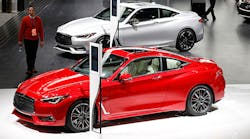The North American International Auto Show this week is stuffed with cars. Not 6,000-pound SUVs or spacecraft-hauling pickup trucks, but regular old sedans and coupes — spinning on the industry’s greatest stage like so many boring vanilla cakes.
Of the 20 or so new models unveiled in Detroit, about half were low to the ground. Granted, these pedestrian cruisers are laced with carbon fiber and the stirrings of self-driving technology, but in form and function, this is innovation circa 1980. There’s even a Swedish station wagon in the mix.
Kia rolled out a four-door grand-touring sedan called the Stinger, Mercedes showed a coupe version of its E-Class, and Toyota pulled the cover off a thoroughly updated Camry. Porsche, ever speedy, beat everyone — in October, it shipped over its overhauled Panamera, a four-door sedan, to show off to journalists in New York.
Given recent sales trends, this crush of short cars seems like a strategic disaster. After all, cheap gas has fueled the SUV fever running rampant across America and now even spreading around the world. Utilities, trucks, and so-called crossovers made up two-thirds of all vehicles bought in the U.S. last year. ”There is a clear trend towards trucks and we don’t see any reason why it should stop,” BMW North America CEO Ludwig Willisch said.
The momentum for SUV mania is built on strong engineering. Utility vehicles used to be a trade-off: In exchange for a higher riding position and a bit more safety, consumers sacrificed driving dynamics and mileage. But SUVs today are built largely like cars, with lightweight metals and efficient engines allowing them to perform almost as well as lower-slung siblings, both on the road and at the fuel pump. Last year, in the U.S. luxury market alone, car sales skidded by 172,000 vehicles, while consumers bought 99,000 more swanky SUVs.
“The reality is we have a lineup of four very fine automobiles, but in a market that almost seems to be in a state of free fall,” Cadillac President Johan de Nysschen said.
So what futuristic machine did Cadillac bring to lure the masses to its stand? Not an SUV, but a relatively big, swanky sedan. BMW did the same.
Car executives aren’t dense, despite what Dieselgate and the Pontiac Aztek might suggest. But when it comes to SUVs, they know something most people in a dealership don’t: Drivers in large part buy the machines that car companies want them to buy.
Lately, most of the newest models have been SUVs. New models make the most money, eat up advertising budgets, and get prime position on showroom floors. In short, the SUV boom is to some extent self-propagating. “There’s definitely a bit of a chicken-and-egg thing there,” said Drew Slaven, vice president of marketing at Mercedes-Benz USA.
But down in the trenches, things are beginning to change. Mercedes dealers have recently asked the company to “take the foot off the pedal” with SUV marketing, Slaven said. At the Mercedes stand in Detroit this week, less than one-third of the vehicles were crossovers or utilities.
Falling Less Quickly
Most executives don’t expect the traditional car to make a roaring comeback, at least not right away. Cadillac is rushing to build a small SUV, for example, while BMW designers are crunching on a massive one. What they do expect is for the decline in sedan and coupe sales to slow, largely because any spike in gas prices, for one, may give them a jolt just as it did in the mid-2000s.
More broadly (and regardless of geopolitics), drivers who want to stand out will eventually drift from the SUV lane. Just like those who bought Jeeps in the 1980s and Ford Explorers in the 1990s, tastes sometimes just change.
“There is always a counter-swing,” said Scott Keogh, president of Audi of America, whose marketing muscle last year helped make its new, midsize A4 an exception to the SUV rule with a 15.3% sales bump. “There will be a generation that comes that says, ‘The SUV was my dad’s car and the SUV was that snooty banker’s car.’”
Volvo, for example, rolled out an opulent sedan last year. And while no stranger to the SUV market, the automaker’s Detroit offering this year is a station wagon, the V90. ”I’ve been stating for 10 years now that sport wagons will come back in the U.S.,” said Volvo’s North America CEO Lex Kerssemakers. “If you’ve been raised in SUVs, by definition you’ll want to do something different from your parents.”
More Room to Maneuver
There’s also a bit of game theory involved. Car companies committed to sedans and coupes are expecting the field to thin, making room for some new blood. In Detroit alone, executives recently announced plans to idle the Chevrolet SS, the Chrysler 200, and the Dodge Dart. Sure, the auto business will eventually cede to Uber-driving robots and ride-sharing Google pods, but there’s a lot of money to be made in the meantime.
De Nysschen, at Cadillac, said consumer tastes will always ebb and flow. “It was sedans and then it was wagons and then it became vans and then crossovers,” he explained. “Now you’re getting crossovers that are getting lower. … If we carry on long enough, we’re back to hatchbacks.”
By Kyle Stock



